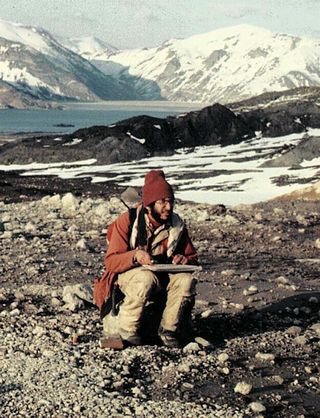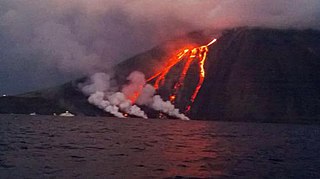Related Research Articles

A volcano is a rupture in the crust of a planetary-mass object, such as Earth, that allows hot lava, volcanic ash, and gases to escape from a magma chamber below the surface.

Mount Vesuvius is a somma-stratovolcano located on the Gulf of Naples in Campania, Italy, about 9 km (5.6 mi) east of Naples and a short distance from the shore. It is one of several volcanoes forming the Campanian volcanic arc. Vesuvius consists of a large cone partially encircled by the steep rim of a summit caldera, resulting from the collapse of an earlier, much higher structure.

Volcanology is the study of volcanoes, lava, magma and related geological, geophysical and geochemical phenomena (volcanism). The term volcanology is derived from the Latin word vulcan. Vulcan was the ancient Roman god of fire.

A volcanologist, or volcano scientist, is a geologist who focuses on understanding the formation and eruptive activity of volcanoes. Volcanologists frequently visit volcanoes, sometimes active ones, to observe and monitor volcanic eruptions, collect eruptive products including tephra, rock and lava samples. One major focus of inquiry in recent times is the prediction of eruptions to alleviate the impact on surrounding populations and monitor natural hazards associated with volcanic activity. Geologists who research volcanic materials that make up the solid Earth are referred to as igneous petrologists.

Kīlauea is an active shield volcano in the Hawaiian Islands. Located along the southeastern shore of Hawai'i Island, the volcano is between 210,000 and 280,000 years old and emerged above sea level about 100,000 years ago. Historically, it is the most active of the five volcanoes that together form the island of Hawaii. Kīlauea is also one of the most active volcanoes on Earth, with the most recent eruption from June 7–19, 2023 after a series of earthquakes, when multiple vents erupted lava within Halemaʻumaʻu, a pit crater in the volcano's summit caldera, and building a fissure cinder cone approximately 40 m (130 ft) high. Halema'uma'u has been the sole eruptive area of Kīlauea since December 2020 with intermittent lava effusion from then to March 7, 2023, followed by a 90-day pause.

The Japan Meteorological Agency, abbreviated JMA, is an agency of the Ministry of Land, Infrastructure, Transport and Tourism. It is charged with gathering and providing results for the public in Japan that are obtained from data based on daily scientific observation and research into natural phenomena in the fields of meteorology, hydrology, seismology and volcanology, among other related scientific fields. Its headquarters is located in Minato, Tokyo.

The volcanism of Italy is due chiefly to the presence, a short distance to the south, of the boundary between the Eurasian Plate and the African Plate. Italy is a volcanically active country, containing the only active volcanoes in mainland Europe. The lava erupted by Italy's volcanoes is thought to result from the subduction and melting of one plate below another.

David Alexander Johnston was an American United States Geological Survey (USGS) volcanologist who was killed by the 1980 eruption of Mount St. Helens in the U.S. state of Washington. A principal scientist on the USGS monitoring team, Johnston was killed in the eruption while manning an observation post six miles (10 km) away on the morning of May 18, 1980. He was the first to report the eruption, transmitting "Vancouver! Vancouver! This is it!" before he was swept away by a lateral blast; despite a thorough search, Johnston's body was never found, but state highway workers discovered remnants of his USGS trailer in 1993.

Harry Glicken was an American volcanologist. He researched Mount St. Helens in the United States before and after its 1980 eruption, and was very distraught about the death of volcanologist David A. Johnston, who was Glicken's mentor and supervisor in Spring 1980 at Mount St. Helens. Glicken was initially assigned to the USGS observation post in the weeks leading up to the eruption but was called away the night before the eruption.

The Soufrière Hills are an active, complex stratovolcano with many lava domes forming its summit on the Caribbean island of Montserrat. After a long period of dormancy, the Soufrière Hills volcano became active in 1995 and has continued to erupt ever since. Its eruptions have rendered more than half of Montserrat uninhabitable, destroying the capital city, Plymouth, and causing widespread evacuations: about two-thirds of the population have left the island. Chances Peak in the Soufrière Hills was the highest summit on Montserrat until the mid-1990s, but it has since been eclipsed by various rising and falling volcanic domes during the recent volcanic activity.
The Volcano Disaster Assistance Program (VDAP) was developed by the U.S. Geological Survey and the United States Agency for International Development's Office of U.S. Foreign Disaster Assistance after the eruption of Nevado del Ruiz (Colombia) in 1985. The volcanic eruption melted a glacier triggering a lahar that killed 25,000 people. It was determined that increased monitoring and enhanced communications between scientists and civil authorities would make it easier to evacuate local populations and save lives. Today the program responds to volcanic crises around the world. The aim of the program is to assist in saving lives and property, to reduce economic losses, and to prevent a natural hazard becoming a natural disaster. VDAP staff members are based at the USGS Cascades Volcano Observatory, in Vancouver, Washington. VDAP channels its energy into four main activities: response to natural disaster, capacity building, training, and volcanological research.

Prediction of volcanic activity, or volcanic eruption forecasting, is an interdisciplinary monitoring and research effort to predict the time and severity of a volcano's eruption. Of particular importance is the prediction of hazardous eruptions that could lead to catastrophic loss of life, property, and disruption of human activities.

The David A. Johnston Cascades Volcano Observatory (CVO) is a volcano observatory in the US that monitors volcanoes in the northern Cascade Range. It was established in the summer of 1980, after the eruption of Mount St. Helens. The observatory is named for United States Geological Survey (USGS) volcanologist David A. Johnston, who was swept away in the Mount St. Helens eruption on the morning of May 18, 1980. The observatory's current territory covers Oregon, Washington, and Idaho. The Cascade Range's extent includes northern California, and Cascade volcanoes in that state, such as Mount Shasta and Lassen Peak, previously fell under the CVO's jurisdiction. However, these volcanoes now fall under the jurisdiction of the California Volcano Observatory (CalVO), formed in February 2012 and based in Menlo Park, California, which monitors and researches volcanic activity throughout California and Nevada.

The California Volcano Observatory (CalVO) is the volcano observatory that monitors the volcanic and geologic activity of California and Nevada. It is a part of the Volcano Hazards Program of the United States Geological Survey, a scientific agency of the United States government.

A volcanic hazard is the probability a volcanic eruption or related geophysical event will occur in a given geographic area and within a specified window of time. The risk that can be associated with a volcanic hazard depends on the proximity and vulnerability of an asset or a population of people near to where a volcanic event might occur.

The Colombian Geological Survey (CGS) is a scientific agency of the Colombian government in charge of contributing to the socioeconomic development of the nation through research in basic and applied geosciences of the subsoil, the potential of its resources, evaluating and monitoring threats of geological origin, managing the geoscientific knowledge of the nation, and studying the nuclear and radioactive elements in Colombia.
The National Volcano Early Warning and Monitoring System is a U.S. federal program within the U.S. Geological Survey for monitoring volcano activity and providing early warning to threatened areas. It was authorized by the John D. Dingell, Jr. Conservation, Management, and Recreation Act on March 12, 2019.

The 2002 Stromboli tsunami was a tsunami caused by a volcanic eruption on the island of Stromboli, in the Aeolian Islands of Sicily, located on the Tyrrhenian Sea. In May 2002, one of the island's two active volcanoes, called Stromboli, entered a new phase of explosive activity that was initially characterized by gas and ash emission from the summit craters. On December 30, 2002, the seismic network recorded two large collapses of a huge portion of the Sciara del Fuoco, which resulted in the tsunamis. The first landslide was around 13:15 and the second one around 13:23 which lasted for 5–7 minutes. The event caused damages on the eastern coast side of Stromboli and Panarea. These tsunamis have been considered the most violent ones that have struck Stromboli in the past 100 years.

The 2022 eruption of Mauna Loa was an episode of eruptive volcanic activity at Mauna Loa, the world's largest active volcano, located on Hawaiʻi island, Hawaiʻi. Mauna Loa began to erupt shortly before midnight HST on November 27, 2022, when lava flows emerged from fissure vents in Moku‘āweoweo. It marked the first eruption at the volcano in 38 years. The eruption ended on December 13, 2022, after more than two weeks.
References
- Thompson, Dick (2002) Volcano Cowboys: The Rocky Evolution of a Dangerous Science Macmillan ISBN 9780312286682 pp 53–59, 142, 175
- James Monroe, Reed Wicander, Richard Hazlett (2006) Physical Geology: Exploring the Earth Cengage Learning ISBN 9781111795658 pg 167
- Rob Young, Lisa Norby (2009) Geological Monitoring pg 273